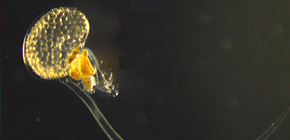
How multicellular animals defend their cells from foreign DNA elucidated
May contribute to simpler methods of gene function analysis
Three researchers* at the Graduate School of Science, Osaka University found the first example of DNA interference phenomenon in multicellular animals using marine plankton Oikopleura dioica. RNA-induced gene silencing system is well known as RNA interference (RNAi) in a wide range of eukaryotes. On the other hand, DNA-induced gene silencing system, known as DNA interference (DNAi), has been only found in a few species of plants, ciliates and archaea and has not been found in multicellular animals.
To examine the effect of DNAi in Oikopleura diocia, these researchers introduced PCR fragments encoding Brachyury gene into O.dioica and found that this decreased the amount of mRNA sequence specifically and induced tail malformation reminiscent of RNAi-mediated gene knockdown phenotype of Brachyury. This gene knockdown was induced not only by PCR fragment covering coding region of Brachyury gene but also 5'-flanking region and intron.
Therefore, they found the first example of DNAi in multicellular animals. This phenomenon can be applied for a new gene knockdown method for characterization of gene functions.
* Tatsuya OMOTEZAKO (PhD student), Takeshi ONUMA (Assistant Professor), Hiroki NISHIDA (Professor)
Abstract
RNA interference is widely employed as a gene-silencing system in eukaryotes for host defence against invading nucleic acids. In response to invading double-stranded RNA (dsRNA), mRNA is degraded in sequence-specific manner. So far, however, DNA interference (DNAi) has been reported only in plants, ciliates and archaea, and has not been explored in Metazoa. Here, we demonstrate that linear double-stranded DNA promotes both sequence-specific transcription blocking and mRNA degradation in developing embryos of the appendicularian Oikopleura dioica . Introduced polymerase chain reaction (PCR) products or linearized plasmids encoding Brachyury induced tail malformation and mRNA degradation. This malformation was also promoted by DNA fragments of the putative 5′-flanking region and intron without the coding region. PCR products encoding Zic-like1 and acetylcholine esterase also induced loss of sensory organ and muscle acetylcholinesterase activity, respectively. Co-injection of mRNA encoding EGFP and mCherry, and PCR products encoding these fluorescent proteins, induced sequence-specific decrease in the green or red fluorescence, respectively. These results suggest that O. dioica possesses a defence system against exogenous DNA and RNA, and that DNA fragment-induced gene silencing would be mediated through transcription blocking as well as mRNA degradation. This is the first report of DNAi in Metazoa.

m
Figure 1: Oikopleura dioica (Adult)
Figure 2: PCR products targeting upstream region, exon and intron can induce the same malformation.
Figure 3: Co-injection with mRNAse encoding mCherry(red) and EGFP(green) and PCR-EGFP showed reduction of intensity of EGFP sequence specifically.
To learn more about this research, please view the full research report entitled " DNA interference: DNA-induced gene silencing in the appendicularian Oikopleura dioica " at this page of the Proceedings of the Royal Society of London B website.
Related Link

